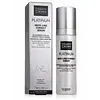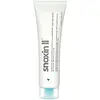What's inside
What's inside
 Key Ingredients
Key Ingredients

 Benefits
Benefits

 Concerns
Concerns

 Ingredients Side-by-side
Ingredients Side-by-side

Water
Skin ConditioningCyclopentasiloxane
EmollientGlycerin
HumectantGlycine Soja Protein
EmulsifyingDimethicone
EmollientPhenyl Trimethicone
Skin ConditioningPolysilicone-11
Lepidium Sativum Sprout Extract
Skin ConditioningBis-PEG/PPG-14/14 Dimethicone
EmollientButylene Glycol
HumectantSqualene
EmollientCoco-Glucoside
CleansingGlaucine
Skin ConditioningLecithin
EmollientTocopherol
AntioxidantLentinus Edodes Extract
Skin ConditioningSoy Isoflavones
Skin ConditioningAscorbyl Palmitate
AntioxidantCitric Acid
BufferingAcetyl Tetrapeptide-2
Skin ConditioningAscorbic Acid
AntioxidantPhytic Acid
Biotin
AntiseborrhoeicCyclohexasiloxane
EmollientHydroxyethyl Acrylate/Sodium Acryloyldimethyl Taurate Copolymer
Emulsion StabilisingPEG-6 Caprylic/Capric Glycerides
EmulsifyingAmmonium Acryloyldimethyltaurate/Vp Copolymer
Polysorbate 80
EmulsifyingAlcohol
AntimicrobialDimethicone/Vinyl Dimethicone Crosspolymer
Skin ConditioningDisodium EDTA
PEG/PPG-18/18 Dimethicone
EmulsifyingPolysorbate 60
EmulsifyingEthylhexylglycerin
Skin ConditioningCaprylyl Glycol
EmollientPEG-8
HumectantSodium Citrate
BufferingPentaerythrityl Tetra-Di-T-Butyl Hydroxyhydrocinnamate
AntioxidantParfum
MaskingPhenoxyethanol
PreservativePotassium Sorbate
PreservativeSodium Benzoate
MaskingWater, Cyclopentasiloxane, Glycerin, Glycine Soja Protein, Dimethicone, Phenyl Trimethicone, Polysilicone-11, Lepidium Sativum Sprout Extract, Bis-PEG/PPG-14/14 Dimethicone, Butylene Glycol, Squalene, Coco-Glucoside, Glaucine, Lecithin, Tocopherol, Lentinus Edodes Extract, Soy Isoflavones, Ascorbyl Palmitate, Citric Acid, Acetyl Tetrapeptide-2, Ascorbic Acid, Phytic Acid, Biotin, Cyclohexasiloxane, Hydroxyethyl Acrylate/Sodium Acryloyldimethyl Taurate Copolymer, PEG-6 Caprylic/Capric Glycerides, Ammonium Acryloyldimethyltaurate/Vp Copolymer, Polysorbate 80, Alcohol, Dimethicone/Vinyl Dimethicone Crosspolymer, Disodium EDTA, PEG/PPG-18/18 Dimethicone, Polysorbate 60, Ethylhexylglycerin, Caprylyl Glycol, PEG-8, Sodium Citrate, Pentaerythrityl Tetra-Di-T-Butyl Hydroxyhydrocinnamate, Parfum, Phenoxyethanol, Potassium Sorbate, Sodium Benzoate
Water
Skin ConditioningGlycerin
HumectantCyclopentasiloxane
EmollientSodium Acrylate/Sodium Acryloyldimethyl Taurate Copolymer
Emulsion StabilisingDimethicone
EmollientCyclohexasiloxane
EmollientIsohexadecane
EmollientPhenoxyethanol
PreservativeCaprylyl Glycol
EmollientPolysorbate 80
EmulsifyingLecithin
EmollientPolysilicone-11
Hydroxypropyl Cyclodextrin
MaskingPalmitoyl Tripeptide-38
Skin ConditioningHexanoyl Dipeptide-3 Norleucine Acetate
Skin ConditioningS-Mu-Conotoxin Cniiic Acetate
Skin ConditioningWater, Glycerin, Cyclopentasiloxane, Sodium Acrylate/Sodium Acryloyldimethyl Taurate Copolymer, Dimethicone, Cyclohexasiloxane, Isohexadecane, Phenoxyethanol, Caprylyl Glycol, Polysorbate 80, Lecithin, Polysilicone-11, Hydroxypropyl Cyclodextrin, Palmitoyl Tripeptide-38, Hexanoyl Dipeptide-3 Norleucine Acetate, S-Mu-Conotoxin Cniiic Acetate
 Reviews
Reviews

Ingredients Explained
These ingredients are found in both products.
Ingredients higher up in an ingredient list are typically present in a larger amount.
Caprylyl Glycol is a humectant and emollient, meaning it attracts and preserves moisture.
It is a common ingredient in many products, especially those designed to hydrate skin. The primary benefits are retaining moisture, skin softening, and promoting a healthy skin barrier.
Though Caprylyl Glycol is an alcohol derived from fatty acids, it is not the kind that can dry out skin.
This ingredient is also used as a preservative to extend the life of products. It has slight antimicrobial properties.
Learn more about Caprylyl GlycolCyclohexasiloxane is a type of silicone more commonly known as D6. It is an emollient and solvent.
Cyclohexasiloxane is used to evenly distribute ingredients throughout the product. When applied to the skin, Cyclohexasiloxane evaporates and leaves behind a silky feel.
As an emollient, it can help the skin feel soft and hydrated. It is also used to reduce frizz in hair products.
Learn more about CyclohexasiloxaneCyclopentasiloxane, or D5, is a silicone used to improve texture of products and trap moisture.
D5 is considered lightweight and volatile. Volatile means it evaporates quickly after application. Once evaporated, D5 leaves a thin barrier that helps keep skin hydrated.
It is also an emollient. Emollients help soften the skin and prevent water loss. Silicones create a silky texture in products. D5 helps other ingredients become more spreadable.
Studies show D5 is safe to use in skincare products. We recommend speaking with a skincare professional if you have concerns.
Learn more about CyclopentasiloxaneDimethicone is a type of synthetic silicone created from natural materials such as quartz.
What it does:
Dimethicone comes in different viscosities:
Depending on the viscosity, dimethicone has different properties.
Ingredients lists don't always show which type is used, so we recommend reaching out to the brand if you have questions about the viscosity.
This ingredient is unlikely to cause irritation because it does not get absorbed into skin. However, people with silicone allergies should be careful about using this ingredient.
Note: Dimethicone may contribute to pilling. This is because it is not oil or water soluble, so pilling may occur when layered with products. When mixed with heavy oils in a formula, the outcome is also quite greasy.
Learn more about DimethiconeGlycerin is already naturally found in your skin. It helps moisturize and protect your skin.
A study from 2016 found glycerin to be more effective as a humectant than AHAs and hyaluronic acid.
As a humectant, it helps the skin stay hydrated by pulling moisture to your skin. The low molecular weight of glycerin allows it to pull moisture into the deeper layers of your skin.
Hydrated skin improves your skin barrier; Your skin barrier helps protect against irritants and bacteria.
Glycerin has also been found to have antimicrobial and antiviral properties. Due to these properties, glycerin is often used in wound and burn treatments.
In cosmetics, glycerin is usually derived from plants such as soybean or palm. However, it can also be sourced from animals, such as tallow or animal fat.
This ingredient is organic, colorless, odorless, and non-toxic.
Glycerin is the name for this ingredient in American English. British English uses Glycerol/Glycerine.
Learn more about GlycerinLecithin is a term for a group of substances found in the cell membranes of plants, animals, and humans. They are made up of mixture of phospholipids.
This ingredient has emollient and emulsifying properties.
As an emollient, lecithen helps soften the skin and creates a barrier to keep moisture in.
As an emulsifier, it also helps prevent water and oil ingredients from separating. Lecithin can also help ingredients be better absorbed by the skin.
This is because the phospholipids in lecithin produce liposomes. Liposomes help other ingredients get through the skin barrier.
Depending on the source of this ingredient, lecithin may not be fungal acne safe. This is because some sources of lecithin come from soybean oil, which may feed the malassezia yeast that feeds fungal acne.
We recommend reaching out to the brand you are purchasing from to inquire about the source of their lecithin.
Some other names for this ingredient include soy lecithin and deoiled soy lecithin.
Learn more about LecithinPhenoxyethanol is a preservative that has germicide, antimicrobial, and aromatic properties. Studies show that phenoxyethanol can prevent microbial growth. By itself, it has a scent that is similar to that of a rose.
It's often used in formulations along with Caprylyl Glycol to preserve the shelf life of products.
Polysilicone-11 is a film-forming silicone that creates a non-tacky and matte finish on the skin. It's commonly used to improve texture, absorb excess oil, and help active ingredients spread evenly.
Due to its "rubber-like" structure, it stays on the skin's surface instead of being absorbed. On the skin, it creates a flexible layer that enhances wearability and stability.
Polysorbate 80 is a surfactant and emulsifier. It is used to keep ingredients together, and prevent oils and waters from separating.
It is made from polyethoxylated sorbitan and oleic acid. This ingredient can be found in cosmetics, foods, and medicine. It is water-soluble.
Polysorbate 80 may not be fungal acne safe.
Learn more about Polysorbate 80Water. It's the most common cosmetic ingredient of all. You'll usually see it at the top of ingredient lists, meaning that it makes up the largest part of the product.
So why is it so popular? Water most often acts as a solvent - this means that it helps dissolve other ingredients into the formulation.
You'll also recognize water as that liquid we all need to stay alive. If you see this, drink a glass of water. Stay hydrated!
Learn more about Water